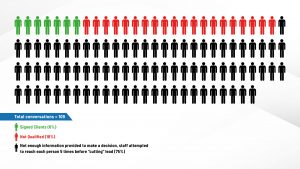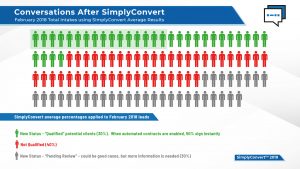Traditional Legal Intake Process…Disrupted
Jessie Hoerman
Jan 05, 2020

Mass Torts 360 Overview

Camp Lejeune

Boy Scouts of America

Mass Torts 360 Overview

Camp Lejeune

Boy Scouts of America


More than half of legal clients shop around before hiring a lawyer. Today more than ever, it is important for lawyers to understand what legal consumers are looking for when contacting a lawyer. According to the Clio Legal Trends Report, more than 82% of potential legal clients site timeliness as a priority to hiring a lawyer and 81% want a response to their legal question.
No lawyer should be surprised by the Clio Legal Trends Report. We don’t simply exist as legal service providers, the majority of us are also consumers who have grown accustomed to instant information/service. How many of us have not used Amazon, Uber, Google Maps, Yelp, or any Food delivery service? Is it unfair for our same expectations as consumers to be applied to law firm client responsiveness?
You may be thinking, my firm has the intake process covered. We use live chat and we hired an after hours call center. We have taken steps to make sure that engage potential clients all the time.
But, ask yourself, is that the level of responsiveness expected today?
Consider this…you’re shopping on Amazon for your mom’s birthday gift. You decide on a crockpot and you throw it in your Amazon cart and purchase it immediately. Would you still want the crockpot if you had to wait for the company selling it to call you to gather information from you a day or two later?
As a consumer you expect instant assistance, and Amazon gives that to you.
Generally, the traditional legal intake process starts with a potential client filling out a contact form, talking to a live chat agent or talking to a poorly trained intake specialist. There are very few law firms that have a lawyer who can qualify cases chatting with potential clients 24/7.
And, under the old traditional legal model, here is what law intakes looked like for the month:

This is one month in the life of TorHoerman Law, a personal injury and mass tort law firm.
In February 2018, before TorHoerman Law disrupted their intake process, they were contacted by 109 individuals that believed they would qualify as clients. TorHoerman Law signed 7 clients in February 2018 under the traditional law firm intake model for a case conversion rate of 6.4%.
Ultimately, the biggest issue was that TorHoerman Law had to reach out to 109 people to gather more information because the traditional intake model generally did not gather enough information to determine case qualification.
TorHoerman Law had a policy of emailing and calling five times in order to gather more information. In February 2018, that amounted to 45+ hours of staff time spent chasing down leads for 7 signed cases.
Ultimately, TorHoerman Law determined that they would not be able to help 20 of these individuals, but, in February 2018 there were 82 unreachable individuals, some of which appear to be missed opportunities based on preliminary notes. TorHoerman Law existed under this traditional law firm model for over 3 years and it is the model followed by most law firms today.
According to Clio Reports 2019 Legal Trend reports 45 % of clients expect to hear from a lawyer within 24 hours, 24% within a few hours and 10 % within an hour. If a law firm reaches out beyond 24 hours, they will not meet the expectations of 79% of potential clients.
And though most law firms believe they are meeting expectations, 64% of the potential clients surveyed by Clio say they contacted a law firm that never responded to them.
In SimplyConvert studies, we have found that more than 60% of contacts by potential clients are made outside business hours. Will your firm meet the expectations of legal consumers in 2021 and beyond or do you look more like TorHoerman Law before disrupting their legal intake process?
 The most obvious change to this intake funnel is that every potential client that reaches out is asked relevant, criteria-based questions based on their legal issue from a lawyer taught virtual legal assistant. This eliminates the largest problem with the traditional legal intake model: the unknown.
The most obvious change to this intake funnel is that every potential client that reaches out is asked relevant, criteria-based questions based on their legal issue from a lawyer taught virtual legal assistant. This eliminates the largest problem with the traditional legal intake model: the unknown.
Most law firms that have disrupted their outdated intake system will tell you that they find the most value in providing automatic declines to individuals they are unable to assist. This one, simple change will save your firm a significant amount of staff time and frustration.
The very last improvement, and the single biggest improvement to increasing client conversion rates is the ability to automatically provide contracts to individuals that meet your criteria. Your virtual legal assistant does not sleep, take breaks or take vacation, so your ability to provide a contract to a qualified potential client happens around the clock.
TorHoerman Law has found that client conversion rates are 30% on average, as opposed to 6% under their outdated legal intake model.
Disruption is often resisted. But, if you’re still not sold on treating your clients as they hope to be treated, then see if the results don’t convince you. Shutting down Live Chat alone and moving to SimplyConvert will save you 40%. And, if your firm decides to automate contracting to qualified individuals, you can expect to see an increase in signed cases of 500% and a decrease cost per signed case of 80%.
The last question for you to consider is this one: now that disruption has occurred, who will take advantage of it first – you or your competitor?
Sources:
Clio Legal Trends Report 2019: https://www.clio.com/wp-content/uploads/2019/10/2019-Legal-Trends-Report.pdf